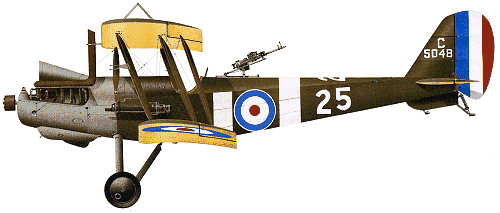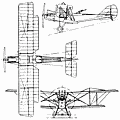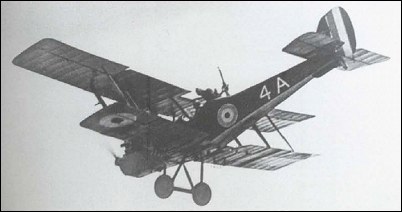|
| Known as the 'Harry Tate', the R.E.8 looked a little like a scaled-up B.E.2. During the course of the latter half of World War I no less than 4,077 were built for the RFC/RAF and a few for Belgium. R.E.8s for British service standardised on the 112kW RAF 4a engine. During a brief spell on the Western Front in late 1916 several were lost through accidents, resulting in their temporary withdrawal. However from early 1917 the aircraft settled to a steady career as a reconnaissance aircraft and light bomber on the Western Front and in Palestine and Italy, remaining active until the Armistice. FACTS AND FIGURES © The RE.8 had a forward-firing
machine gun set at an angle so
the pilot could fire it, but
where the bullets would miss
the propeller. This made hitting
an opponent almost impossible. © At least on early model RE.8s the
observer could not turn around in his
seat or fire the rear gun from a standing
position, so he had to somehow aim
and fire it over his shoulder. © The tendency to spin was reduced
by fitting a venrral fin at the base
of the tail. This further reduced
what little agility the RE.8 had.

| ENGINE | 1 x RAF 4a, 112kW |
| WEIGHTS |
| Take-off weight | 1300 kg | 2866 lb |
| Empty weight | 717 kg | 1581 lb |
| DIMENSIONS |
| Wingspan | 12.98 m | 43 ft 7 in |
| Length | 8.5 m | 28 ft 11 in |
| Height | 3.47 m | 11 ft 5 in |
| Wing area | 35.07 m2 | 377.49 sq ft |
| PERFORMANCE |
| Max. speed | 164 km/h | 102 mph |
| Ceiling | 4115 m | 13500 ft |
| ARMAMENT | 2 x 7.7mm machine-guns, 100kg of bombs |
 | A three-view drawing (662 x 664) |
| Tim Spencer, e-mail, 11.02.2024 10:06 I just came across this page while researching my grandfathers RFC /RAF service as he also served in the North Russia Campaign (NREF).
He flew RE 8's (A4733 and B5083) and possibly DH4's in Russia.
It has been an interesting journey as he flew with several different airmen (that I can find on online records), one who also was awarded a DFC.
He also flew with the following officers;
2Lt. F (Frank) Belway (Canadian)
Lt. KW (Kenneth William) Murray - KIA (W of Monchy, France)
2Lt. HL (Horace Levick) Wilson - KIA (W of Monchy, France)
I'm still slowly trawling the web for more details.. reply |
| Roger Romney Brown, e-mail, 05.07.2023 22:44 I'm writing about a Captain from an Infantry Regiment who transferred
to the RFC in 1917 and was posted to No 16 Squadron RFC as an Observer /Gunner.
Two questions- Does anyone one know of the colour scheme of the RE 8'S in 16 Squadron?
Can I use photo's from this site of R.E.8'S to go in my atricle?
Thank you. reply | | Roger Delgado, e-mail, 10.09.2022 05:46 Are there any relatives of No.3 squadron AFC. reply | | Roger Delgado, e-mail, 25.08.2022 09:29 Does anyone know the markings on R.E.8’s A3661 and B6576 of No.3 squadron AFC?
These two aircraft were involved in the Red Baron’s last dogfight. reply | |
| | Anonymous, 03.12.2021 17:11 Although a marked improvement over the B.E.2c, the R.E.8 was still designed with positive stability in mind rather than maneuverability because stability was still regarded as a far more important quality for a reconnaissance airplane than agility. However, by the time the R.E.8 appeared there were better alternatives available, such as the Bristol Fighter and de Havilland DH-4. reply | | Peter G. Cox, e-mail, 06.07.2020 00:20 Sven, From Wikipedia I offer the following explanation:
The term "Harry Tate" entered the 20th century English (British) language as a form of cockney rhyming slang, initially meaning "late", because of Tate's comedic routines about automotive troubles. Around mid-1915, "Harry Tate" began to serve as slang for "plate". When the Royal Aircraft Factory R.E.8 biplane was introduced in late 1916 and 1917, the "R.E.8" designation spoken aloud was observed to sound similar to Tate's name, so the fliers nicknamed the aeroplane "Harry Tate". After the war, "Harry Tate" settled into a meaning of "state" in cockney rhyming slang. reply | | Sven, 03.12.2015 01:49 Oh! I nearly forgot.A prize of one old penny for the first person to explain the Harry Tate nickname. reply | | Sven, 03.12.2015 01:43 I would echo John seabrooks comments and add that the Harry tate was another aircraft that was successful because it was there in numbers and tough enough for its tasks. Too often the work horse is overlooked because of the thoroughbread in the limelight. The crews? Brave men on both sides. reply | | john seabrook, e-mail, 03.12.2015 00:12 The RE8 was an unforgiving aeroplane to fly but could perform outside of it`s expected parameters when flown aggressively. Several Australian pilots became aces on the type. It was not the lumbering pushover it is often portrayed as.... reply | | Darryl F Smith, e-mail, 11.06.2015 07:01 Found a open book at air museum in Perth ,West.Australia ,page showed our GRANDADS name ,he had done a test flight in plane number 5079 on 22-APRIL-1918. Took a pic of the page,felt proud as.His name was Hugh S Foal,(LT). reply |
| Tony Deamer, e-mail, 25.11.2014 22:12 My Grand Father ,Sydney Harold Deamer Also flew one and was shot in the leg while doing so ,over France, since then successive generations have either flown or owned air craft
Robin Deamer Flies DH6 Air Craft in Myanmar and Parviz Deamer is in Aerospace engineering reply | | geoff milner, e-mail, 11.12.2012 13:58 my grandfather george milner was a pilot and observer on RE8 in 9 sqn,12 sqn and 4 sqn.He held the rank of Lt then Capt as a flight commander in 9 sqn. reply | | geoff milner, e-mail, 11.12.2012 13:57 my grandfather george milner was a pilot and observer on RE8 in 9 sqn,12 sqn and 4 sqn.He held the rank of Lt then Capt as a flight commander in 9 sqn. reply | | Frank Russell, e-mail, 12.01.2012 05:00 My father was a pilot in the RFC & RAF in WW1 in #6 Sqdn.in France & Belguim and then in Mesopotamia ---- Baghdad etc --- with their RE8s. --- They also had Bristol Fighters --- reply | |
| | Klaatu, e-mail, 29.08.2011 22:34 The R.E.8 was designed to succeed the BE2C as the RFC's standard reconnaissance and artillery spotting airplane. However, it's only real advantage over the older plane was that the observer was seated behind the pilot, where he enjoyed a better view and a better field of fire for his machine gun. Speed, climb and maneuverability were little improved over the BE2C, which first flew before World War I. reply | | Noname, e-mail, 31.03.2020 10:24 My grandfather flew in one, BTW reply | | Doidy, e-mail, 16.12.2010 12:46 My gt grandparents, William & Mary Morgan "sort of adopted" a young man named Clifton Frederick Alban, who served in WW1 as Clifton Frederick Bailey (his mmn).A small group of us have been researching him, because he was so well thought of in our family 3 subsequent generations were named Clifton. Here is what we have found so far. The biggest mystery though is just how he came to be "taken under the wing of the Morgan family? We would love to hear from anyone who might be able to tell us more.
Clifton was born in March 1897 at Christchurch, Hampshire. Clifton Frederick Samuel Alban is named as his Father. He (C.F.S.A) had had a twenty year career in India in the Bombay Staff Corps, having served in the Afghan War in 1879-80 (!), taking part in the defence of Kandahar. He was promoted to Major in 1895.
From the 1911 Census, we know that Clifton was already using his Mother's maiden name and was a pupil at Dunshurst Steep School. Part of the Bedales group. He also attended Clayesmore School where he is named on the roll of honour in the school chapel.
He was commissioned in the 7th (City of London) Battalion, the London Regiment, and had been their transport officer while at Ipswich and Sutton Verny. He joined No. 1 School of Aeronautics (Reading) on 2nd October 1916, then No. 12 Reserve Squadron on 17th November 1916 and 13 Reserve Squadron on 10 January 1917. He graduated as a Temporary Lieutenant (Flying Officer) in the Royal Flying Corps on 24th February 1917 and was posted to 59 Squadron RFC in France on 14th March 1917.
The primary task of the RFC was to act as aerial observers. Observers brought back photographs of enemy positions, details of weapons and troop movements The rear observer would have a heavy wooden box camera on the side of the plane and heavy photographic plates were being changed, despite the hail of gunfire going on around them!! He would also act as a gunner when necessary. Clifton's role would have been either to fly in a reconnaissance role or, as escort, to defend these planes from attack from German aircraft and to mount similar attacks on German reconnaissance planes. Tactical flying was part of the training: learning how to swerve and dodge, avoid sun dazzle, loop the loop and so on. Good reflexes were their greatest asset.
On 6th April, after a painfully short period of active service, Clifton was posted as missing after failing to return from escort duty to a photographic flight in the area of Vitry-en-Artois, Arras. He and his colleague in a RE8 left the airfield at 09-35, being shot down at 10-30 in the Thelus-Rouvroy area. His plane was the second victory of Carl Menckhoff of Jagdstaffel 3. This period was known as "bloody April" and two other machines from his squadron also failed to return. reply |
| wendy magnall, e-mail, 09.10.2009 10:02 The RE-8 had an interrupter system and a regular forward firing gun on the port side. You claim the gun shot up over the propeller under "Facts and Figures" but this is not the case, at least not for any model I have found, seen, or read of. (My grandfather flew in one, BTW.) reply | | Bob Hughes, e-mail, 09.03.2007 12:36 I have a photograph of my grandfather and his mates standing round a RAF RE8 circa 1917. The plane carries the numbers C 2464 - is it possible to get any further inforamtion about this particular plane? Thanks reply |
|
Do you have any comments?
|
| 
COMPANY
PROFILE
All the World's Rotorcraft
|




 Darryl F Smith
Darryl F Smith Doidy
Doidy




Update:
2Lt. F Belway was promoted to Capt. and also awarded the DFC 3 Dec 1918.
reply